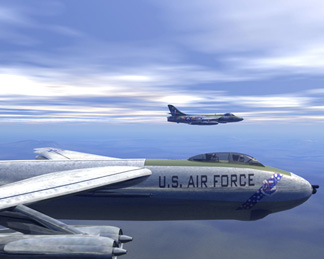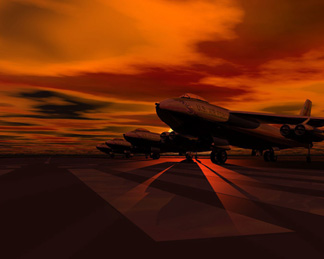Biographical Notes reCharles A. (Chuck) StonePage 5 of 6 Pages, of Chapter 6,THE REAL THING |
||||||
|
Our organization set me up for some air refueling practice sessions to be sure our fuel pressure problems were licked and things went well. I can recall a day that our aircraft was scheduled to make a high speed bomb run at 40 thousand feet on London where the English Hawker Hunters would see if they could make a pass on us. The sky was remarkably blue and clear. Visibility was good. We pushed up the power to the mach limit and could feel the airplane shudder a bit. Way off in the distance I could see the Hawker Hunters lining up for an approach.
|
 |
|||||
|
This image is a drawing by Phil Alexander depicting one of the moments in this engagement with the Hawker Hunter. The situation, at that moment, is perfectly recreated in his beautiful work of art. See more Hawker Hunters
by clicking here. |
||||||
|
I will always remember my thoughts and lessons learned in those moments. I looked out at the fighters and thought to myself “Stone, after all of these years flying junkers from WW II, you are finally on the first team.They will never catch us.” As part of the routine I looked over my instruments and switches and then looked back at what was going on in the outer world. Would you know, a Hawker Hunter pulled up beside us, the pilot gave me the finger, did a quick roll and pulled away, and was soon out of sight. I thought to myself “Stone, you just got off the first team.” That was the reality of it all.
|
||||||
| There was ample time to relax between missions. I put a piece of plywood under my mattress to try and soothe my sensitive back . One of our flying adventures involved a flight of our entire 98th Bomb Wing complement down to Wheelus Air Base, Libya. On the flight down we were assigned three different routings and altitudes. One group would make their approach and practice bomb run from high altitude. One would come in at a medium altitude, and the last group, the one our crew was assigned to, would cross the Mediterranean Sea at wave tops and pop up at the last minute. The idea was to test the radar capabilities of our resources in that area. |
||||||
 |
||||||
|
This is another drawing by Phil Alexander depicting the sun rising on the 98th BW B-47's standing alert at Lakenheath, England
November-December 1955 and January 1956 For a larger view, click here. |
||||||
| Our mission went on schedule. I can recall racing at Mach .74 across the waters and seeing nothing but eyeballs from the crews of the small fishing boats we would pass over. We popped up and went into the landing pattern. Things were going so well that I decided I didn't need to use the brake chute to slow us down on the runway. At Wichita we did it all the time. Some of our operations people in the tower jumped to the conclusion that I had forgotten to use the brake chute, and I had a hard time making them realize I was just trying to save their troops some work. On the trip back, a few days later, we also had a prime objective. It was to conduct a RAPCON saturation of the Lakenheath area radar to see what they could handle and what would fall through the cracks. The entire wing of B-47s was scheduled to arrive over the high cone at Lakenheath at 20,000 feet at about one minute intervals. Again we were traveling one of three separate flight routes. Off we go and all is well. Half way there I get a warning light that tells me that we have lost one of our alternators. This was no big deal, except it was the one that provided the preheating of the slab of Nisa Glass that was our canopy front window. We made it to our point of descent right on time and, dropping gear and full flaps, we were cleared to slide down the chute. Our front windshield was one cold slab of glass. The weather was mixed 500 to 800 foot ceilings, light rain, with cloud tops around 6,000 feet, weather deteriorating. It was daylight, fortunately. We were cleared to 6,000, pending further clearance. As we got to the 6,000 foot level, we were cleared right on down to 1,000 feet. At the time of the further clearance we were in the broad turn back toward the base, just passing through 6,000. We had received our altimeter setting prior to hitting the high cone and I was confident that things were going OK. As we got into the clouds, ice immediately began to build up on our cold front windshield and I lost forward vision. I set the windshield wiper going, trying to beat some of it off. In the meantime, there was condensation developing in the cockpit and this was also freezing on the inside of the Nisa Glass. I reached up to rub off as much of the frost and ice as I could reach, in the meantime continued on down to the 1,000 foot altitude limit. I had just started to level off a couple of hundred feet above 1,000 feet, intending to let down the last bit more slowly. I took a glance outside and realized that we were dashing through the ragged cloud bottoms and I could see a house and a barn approaching at just a bit below eye level. I began an immediate effort to climb, realizing that our altimeter reading might be in error by as much as a 1,000 feet. This error was on the more dangerous, you-are-lower-than-indicated, side of the equation. I could not see any other aircraft from our position, but I could tell from the radio traffic and stream of instructions flowing through the airwaves, things were confused and overloaded. I began an immediate effort to track over to the landing approach heading, using my Omni indicator. Radar Approach Control could not pick us up, yet! I kept trying to clear the ground enough not to run over any sheep or cows, but yet low enough to make a pass on the runway, if we could find it. Coming in at a bit of an angle view, Steve and I both picked up the runway. It was obvious that we would not have to descend very far to get to the concrete. As we lined up with the runway, I could not see forward because of the ice. I kept lowering our airspeed in hopes we could put her down. I finally could see concrete on both sides. I knew we were not very far off the runway, but was afraid we were fast enough to float too long before touchdown. My mind flashed back to Wichita again, telling me that there had been occasions when people had deployed their break chutes in the air, successfully. I reached for the brake chute handle and pulled. We felt the strong tug of deployment, we settled on to the runway like a feather and made the first turnoff taxiway. All this time, the people in the tower were wetting their britches at the airborne brake chute deployment. I had to open the canopy and stick my head out to see where to taxi. It didn't take long for me to learn that there were a few operations types that wanted to have a chat with me. After telling my full story, cooler heads prevailed and I was not strung up on the yard arm. Who knows, it may be that saving the professionally packed brake chute down at Wheelus, may have prevented me from dropping a poorly packed canvas ice-ball on the runway at Lakenheath. A few weeks later we learned that the RAPCON approach controller had given the wrong altimeter setting to six of our airplanes. They were having a record-setting low pressure area over England and the controller who had been so used to saying 29.(something) had used that figure when the air pressure was in the 28.(something) range. It was all on tape. Our altimeters were about a thousand feet in error on the “you are too low” side. Out of the six aircraft, mine was the only one with a frozen, ice covered forward view. Of the six, we were the luckiest of all. In actuality, it could have been that there were six new holes in the ground in the Lakenheath area, but “Thank God” that was not the case. |
||||||
|
End of Page 5 of 6 Pages, Chapter 6 — Go to Page 6 Click below to select a destination Go to Page 1 — 2 — 3 — 4 — 5 — 6, this Chapter Chapters 1 — 2 — 3 — 4 — 5 — 6 — 7 — 8 — 9 — 10 |
||||||